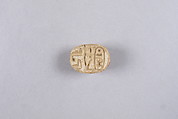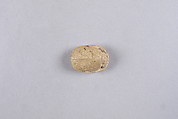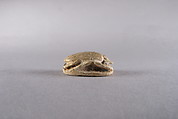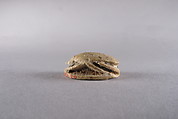Scarab Inscribed with the Names of Seti I and Menkheperre (Thutmose III)
New Kingdom
On the right side of the scarab’s base is an oval – instead of the usual royal cartouche – encompassing hieroglyphs that form the name Menkheperre, the throne name of Thutmose III (Dynasty 18, ca. 1479-1425 B.C.). He was venerated after his death and the name of this great ruler continues to appear on stamp seals long after his reign, even into the Late Period (ca. 664-525 B.C.).
However, this scarab does not date to Dynasty 18 because the other signs and symbols point to a date in the Ramesside Period (Dynasty 19-20, ca. 1295-1070 B.C.). In addition to the name Menkheperre, the other hieroglyphs form the throne name of Seti I ("mn-mAat-rA stp-n-rA"), the first king of Dynasty 19 (ca. 1295-1186 B.C.). The juxtaposition of the throne names of Thutmose III and Seti I is attested on a large number of scarabs, indicating that they were likely manufactured over a long period, throughout the Ramesside Period and perhaps even later.
Due to rights restrictions, this image cannot be enlarged, viewed at full screen, or downloaded.
This artwork is meant to be viewed from right to left. Scroll left to view more.





